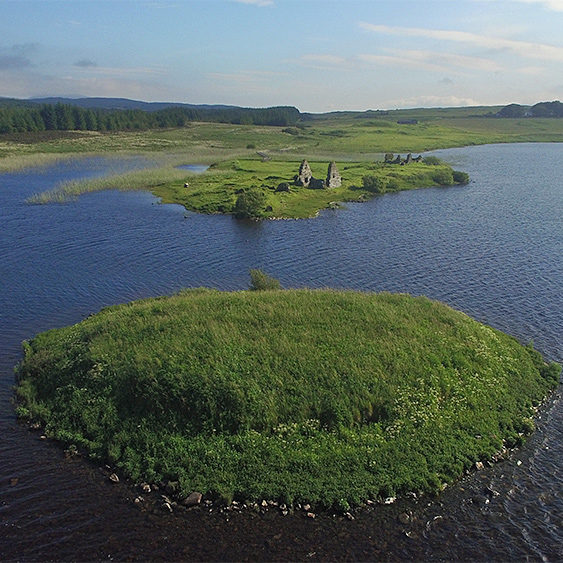14th Century — 15th Century
From the middle of the 14th Century to the end of the 15th Century the Lordship of the Isles dominated the Hebrides and Western Coast of Gaelic Scotland; it was largest and most powerful province in all of Scotland.17 Aligned enemies, allowed the Lordship to grow rapidly in its early days and subordinate several smaller lordships to into itself including the Campbells, the Macleans, the Macleods, and junior branches of the MacDonalds.13
Aligning with the Lordship
By the 14th century, the Macleans had become a dominant force in the Western Isles. In 1366 Lachlan Lùbanach Maclean and his brother Hector had carved out a role for the Macleans in the Lordship. Lachlan Lùbanach later solidified the Maclean alliance with the Macdonalds through marriage. His bride, Mary Macdonald,15 was not only the daughter of John Macdonald, first Lord of the Isles, but also the granddaughter of Robert II, King of Scots. It appears the families were close enough that the approval of the church was sought. The papal dispensation issued by Pope Urban V on May 3rd of 136716 approving the marriage is the first mention of a Maclean in any official records. Their marriage dowry included custody of Duart Castle. Lachlan Lùbanach also secured the hereditary position of Lieutenant-General of the Isles.16
In 1390, Lachlan Lùbanach secured the earliest known known charters for Duart and its surrounding territories from Donald of Islay, 2nd Lord of the Isles, recognizing the grant of Donald’s father, John of Islay.1 The Lordship may have been the first in Western Scotland to adopted the practice of strengthening and extending its power by chartering castles to its most trusted vassals.13 Donald granted three charters to Lachlan Lùbanach at Ardtornish on July 12 in 1390.1 The first charter granted custody and constableship of castle Duart, the lands of Torosay, Brolas and other lands in Mull;2 half constableship of castles Dunconnel and Dunkerd, the islands of Garvellach, the upper half of the isle of Jura, certain lands in Luing, Scarba, Morvern and other places.2 The second charter granted custody and constableship of castles Cairnburgh, Ileburgh, Fladda, and Lunga; the lands of Treshnish, Calgary, and other lands in Mull; the office of Fragramanach and Armanach in the island of lona.2 The third charter granted the bailiery of all the lands of Tiree; certain lands in Tiree; and the office of Steward of the House to the Lord of the Isles.2
Office within the Lordship
John of Islay bestowed upon Lachlan Lùbanach the office of Lieutenant-General of the Isles,16 gave him the honor of the “right hand of all Clans in Battle” and made him the Chamberlain of his household.17 Hector Ruadh, 2nd of Duart, inheriting the military roles, commanded the right flank of the Lordship’s army at the Battle of Harlaw.1 Hector Odhar, 5th of Duart, is known to have inherited the hereditary office of Steward of the Isles.13
Council of the Isles
As the Lordship grew, the Lord of the Isles needed advisors and administrators, so the Council of the Isles was established. Donald Monro, Dean of the Isles, described four distinct ranks within the Council as “Four great men of the royal blood of Clan Donald lineally descended…Four greatest of the nobles, called lords… Four thanes of less living and estate…” and “Freeholders or men that had their lands in factory.”14
The Macleans of Duart and Lochbuie were two of the four greatest nobles within the Lordship along with Macleod of Dunvegan & Harris, and Macleod of Lewis.13 These to branches would remain on the council until the Lordship was annexed by the Scottish Crown.

While their is no direct evidence that either Lachlan or Hector were part of the Council of the Isles themselves, Lachlan’s ability to secure the Duart charters is a strong indicator that he likely was part of the council or at least held influence with it. In 1545 Hector Maclean 8th of Duart, Murdoch Maclaine 6th of Lochbuie, Allan na Sop, John 4th of Coll, John 4th of Ardgour, and Donald 2nd of Kingairloch were identified in 1545 among the last members of the Council.15
Aftermath
For several generations the fortunes of the Macleans were closely tied to the Macdonalds and the Lordship of the Isles. In 1493 King James IV of Scotland seized the land, estates, and titles of the Lordship bringing an end to its control of the Hebrides and Western coastline. Thought the Lordship effectively no longer exists, the title, Lord of the Isles, remains today and is held by the Duke of Rothesay, the heir apparent of the King of Scotland. Since the Acts of Union 1707, the title Duke of Rothseay has usually been born by the Prince of Wales.
The Macleans’ steadfast support as vassals to the Lordship of the Isles was rewarded by—and expected to transition to—the Scottish Crown when it annexed the Lordship to itself. John Og, 5th of Lochbuie, was the first of the Macleans to submit to the Sovereign, who confirmed the charters for Lochbuie.18 On July 13th in 1495 at Glasgow, King James IV confirmed all the charters held by Hector Odhar, 5th of Duart, from the Lord of the Isles.1 Holding their charters directly from the Sovereign made the Macleans an independent from the Lordship, at a time when they were the most powerful military force in the Hebrides.
